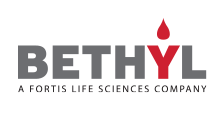NEW!
Goat anti-Mouse IgG1 Heavy Chain Antibody Biotinylated

Bethyl Laboratories
Catalog #
Target:
Mouse IgG1 Heavy Chain
Reactivity:
Mouse
Applications:
ELISA,
ICC,
IF,
IHC,
WB
Host:
Goat
Clonality:
Polyclonal
Format:
Whole IgG
Isotype:
IgG
Conjugate:
Biotin,
FITC,
HRP,
Unconjugated
Purity:
Antigen Affinity Purified
Product Details
Specifications
Verified Reactivity
Mouse
Antigen Species
Mouse
Concentration
1 mg/ml
Storage
2 - 8 °C
Shelf Life
1 year from date of receipt,
2 years from date of receipt
Physical State
Liquid
Buffer
Phosphate Buffered Saline (PBS) containing 0.2% BSA and 0.09% Sodium Azide
Request Formulation Change Phosphate Buffered Saline (PBS) containing 0.2% BSA and 0.05% Pro-Clean 400
Request Formulation Change Phosphate Buffered Saline (PBS) containing 0.09% Sodium Azide
Request Formulation Change
Request Formulation Change Phosphate Buffered Saline (PBS) containing 0.2% BSA and 0.05% Pro-Clean 400
Request Formulation Change Phosphate Buffered Saline (PBS) containing 0.09% Sodium Azide
Request Formulation Change
Production Procedures
Antiserum was solid phase adsorbed to ensure subclass specificity. The antibody was isolated by affinity chromatography using antigen coupled to agarose beads and conjugated to biotin.
Prior to conjugation, immunoglobulin concentration was determined using Beer’s Law where 1mg/mL IgG has an A280 of 1.4.
By immunoelectrophoresis and ELISA this antibody reacts specifically with mouse IgG1. Cross reactivity to mouse IgA, IgM, IgG2a, IgG2b, IgG2c, IgG3 and IgE is less than 1%. Some hybridoma clones may express aberrant immunoglobulin-related peptides that are improperly recognized by this antibody. Antiserum was solid phase adsorbed to ensure subclass specificity. The antibody was isolated by affinity chromatography using antigen coupled to agarose beads and conjugated to horseradish peroxidase (HRP).
Prior to conjugation, immunoglobulin concentration was determined using Beer’s Law where 1mg/mL IgG has an A280 of 1.4. Molar enzyme/antibody protein ratio is 4:1.
By immunoelectrophoresis and ELISA this antibody reacts specifically with mouse IgG1. Cross reactivity to mouse IgA, IgM, IgG2a, IgG2b, IgG2c, IgG3 and IgE is less than 1%. Some hybridoma clones may express aberrant immunoglobulin-related peptides that are improperly recognized by this antibody. Antiserum was solid phase adsorbed to ensure subclass specificity. The antibody was isolated by affinity chromatography using antigen coupled to agarose beads.
Immunoglobulin concentration was determined using Beer’s Law where 1mg/mL IgG has an A280 of 1.4.
By immunoelectrophoresis and ELISA this antibody reacts specifically with mouse IgG1. Cross reactivity to mouse IgA, IgM, IgG2a, IgG2b, IgG2c, IgG3 and IgE is less than 1%. Some hybridoma clones may express aberrant immunoglobulin-related peptides that are improperly recognized by this antibody. Antiserum was solid phase adsorbed to ensure subclass specificity. The antibody was isolated by affinity chromatography using antigen coupled to agarose beads and conjugated to fluorescein isothiocyanate (FITC).
Prior to conjugation, immunoglobulin concentration was determined using Beer’s Law where 1mg/mL IgG has an A280 of 1.4.
By immunoelectrophoresis and ELISA this antibody reacts specifically with mouse IgG1. Cross reactivity to mouse IgA, IgM, IgG2a, IgG2b, IgG2c, IgG3 and IgE is less than 1%. Some hybridoma clones may express aberrant immunoglobulin-related peptides that are improperly recognized by this antibody.
Prior to conjugation, immunoglobulin concentration was determined using Beer’s Law where 1mg/mL IgG has an A280 of 1.4.
By immunoelectrophoresis and ELISA this antibody reacts specifically with mouse IgG1. Cross reactivity to mouse IgA, IgM, IgG2a, IgG2b, IgG2c, IgG3 and IgE is less than 1%. Some hybridoma clones may express aberrant immunoglobulin-related peptides that are improperly recognized by this antibody. Antiserum was solid phase adsorbed to ensure subclass specificity. The antibody was isolated by affinity chromatography using antigen coupled to agarose beads and conjugated to horseradish peroxidase (HRP).
Prior to conjugation, immunoglobulin concentration was determined using Beer’s Law where 1mg/mL IgG has an A280 of 1.4. Molar enzyme/antibody protein ratio is 4:1.
By immunoelectrophoresis and ELISA this antibody reacts specifically with mouse IgG1. Cross reactivity to mouse IgA, IgM, IgG2a, IgG2b, IgG2c, IgG3 and IgE is less than 1%. Some hybridoma clones may express aberrant immunoglobulin-related peptides that are improperly recognized by this antibody. Antiserum was solid phase adsorbed to ensure subclass specificity. The antibody was isolated by affinity chromatography using antigen coupled to agarose beads.
Immunoglobulin concentration was determined using Beer’s Law where 1mg/mL IgG has an A280 of 1.4.
By immunoelectrophoresis and ELISA this antibody reacts specifically with mouse IgG1. Cross reactivity to mouse IgA, IgM, IgG2a, IgG2b, IgG2c, IgG3 and IgE is less than 1%. Some hybridoma clones may express aberrant immunoglobulin-related peptides that are improperly recognized by this antibody. Antiserum was solid phase adsorbed to ensure subclass specificity. The antibody was isolated by affinity chromatography using antigen coupled to agarose beads and conjugated to fluorescein isothiocyanate (FITC).
Prior to conjugation, immunoglobulin concentration was determined using Beer’s Law where 1mg/mL IgG has an A280 of 1.4.
By immunoelectrophoresis and ELISA this antibody reacts specifically with mouse IgG1. Cross reactivity to mouse IgA, IgM, IgG2a, IgG2b, IgG2c, IgG3 and IgE is less than 1%. Some hybridoma clones may express aberrant immunoglobulin-related peptides that are improperly recognized by this antibody.
Country of Origin
USA
Additional Product Information
IgG1 is the most dominant subclass of IgG and is known to be able to cross the placenta, bind strongly to Fc receptors, and activate the complement pathway efficiently.
Applications
Not all listed applications have been specifically tested by our laboratory.
